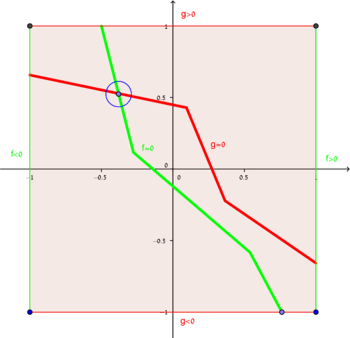Poincaré–Miranda theorem
In mathematics, the Poincaré–Miranda theorem is a generalization of the intermediate value theorem, from a single function in a single dimension, to n functions in n dimensions. It says as follows:
- Consider n continuous functions of n variables. Assume that for every variable xi, the function fi is constantly negative when xi = 0 and constantly positive when xi = 1. Then there is a point in the n-dimensional unit cube in which all functions are simultaneously equal to 0.
The theorem is named after Henri Poincaré, who conjectured it in 1883, and Carlo Miranda, who in 1940 showed that it is equivalent to the Brouwer fixed-point theorem.[1]
Intuitive description

The picture on the right shows an illustration of the Poincaré–Miranda theorem for n = 2 functions. Consider a couple of functions (f,g) whose domain of definition is the [-1,+1]2 square. The function f is negative on the left boundary and positive on the right boundary (green sides of the square), while the function g is negative on the lower boundary and positive on the upper boundary (red sides of the square). When we go from left to right along any path, we must go through a point in which f is 0. Therefore, there must be a "wall" separating the left from the right, along which f is 0 (green curve inside the square). Similarly, there must be a "wall" separating the top from the bottom, along which g is 0 (red curve inside the square). These walls must intersect in a point in which both functions are 0 (blue point inside the square).
Generalizations
The simplest generalization, as a matter of fact a corollary, of this theorem is the following one. For every variable xi, let ai be any value in the range [supxi = 0 fi, infxi = 1 fi]. Then there is a point in the unit cube in which for all i:
- .
The this statement can be reduced to the original one by a simple translation of axes,
where
- xi are the coordinates in the domain of the function
- yi are the coordinates in the codomain of the function
Notes
- ↑ (Kulpa 1997, p. 545).
References
- Dugundji, James; Granas, Andrzej (2003), Fixed Point Theory, Springer Monographs in Mathematics, New York: Springer-Verlag, pp. xv+690, ISBN 0-387-00173-5, MR 1987179, Zbl 1025.47002
- Kulpa, Wladyslaw (June 1997), "The Poincare-Miranda Theorem", The American Mathematical Monthly, 104 (6): 545–550, doi:10.2307/2975081, JSTOR 2975081, MR 1453657, Zbl 0891.47040.
- Miranda, Carlo (1940), "Un'osservazione su un teorema di Brouwer", Bollettino dell'Unione Matematica Italiana, Serie 2 (in Italian), 3: 5–7, JFM 66.0217.01, MR 0004775, Zbl 0024.02203.
External links
- Ahlbach, Connor Thomas (2013). "A Discrete Approach to the Poincare–Miranda Theorem (HMC Senior Theses)". Retrieved 18 May 2015.